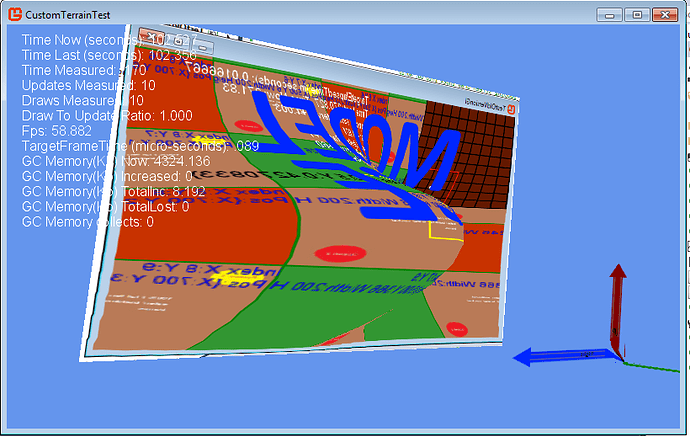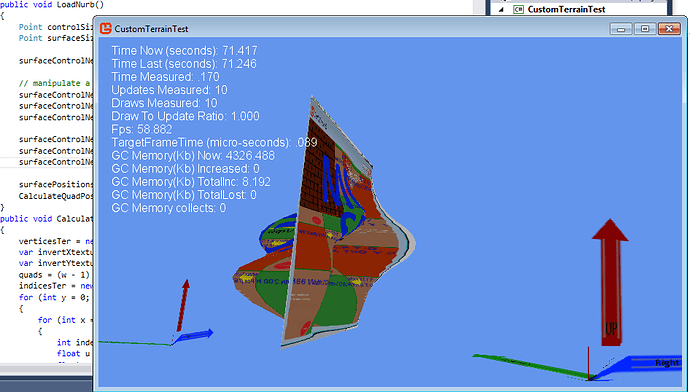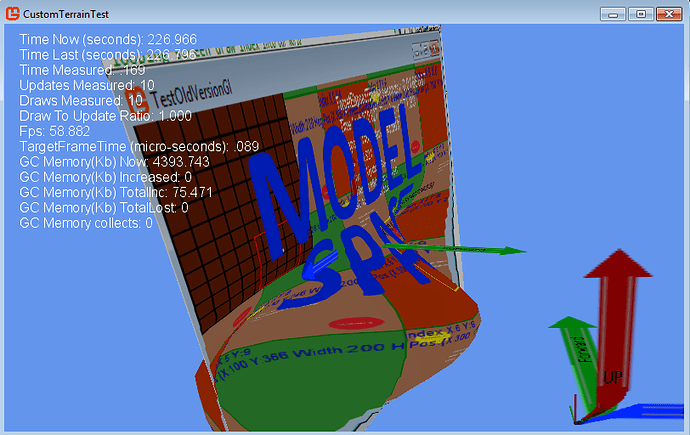Im seeing something that i really don’t understand with my shader, when i add a normal to my custom vertice data structure, then send it to my .fx shader shown below (which doesn’t really do anything) i get problems.
//_______________________________
// PNCMT PosNormalColorMultiTexture fx
#if OPENGL
#define SV_POSITION POSITION
#define VS_SHADERMODEL vs_3_0
#define PS_SHADERMODEL ps_3_0
#else
#define VS_SHADERMODEL vs_4_0_level_9_1
#define PS_SHADERMODEL ps_4_0_level_9_1
#endif
float4x4 gworldviewprojection;
Texture2D TextureA;
sampler2D TextureSamplerA = sampler_state
{
Texture = <TextureA>;
};
Texture2D TextureB;
sampler2D TextureSamplerB = sampler_state
{
Texture = <TextureB>;
};
struct VertexShaderInput
{
float4 Position : POSITION0;
float4 Normal : NORMAL0;
float4 Color : COLOR0;
float2 TexureCoordinateA : TEXCOORD0;
float2 TexureCoordinateB : TEXCOORD1;
};
struct VertexShaderOutput
{
float4 Position : SV_Position;
float4 Normal : NORMAL0;
float4 Color : COLOR0;
float2 TexureCoordinateA : TEXCOORD0;
float2 TexureCoordinateB : TEXCOORD1;
};
struct PixelShaderOutput
{
float4 Color : COLOR0;
};
VertexShaderOutput VertexShaderFunction(VertexShaderInput input)
{
VertexShaderOutput output;
output.Position = mul(input.Position, gworldviewprojection);
output.Normal = input.Normal;
output.Color = input.Color;
output.TexureCoordinateA = input.TexureCoordinateA;
output.TexureCoordinateB = input.TexureCoordinateB;
return output;
}
PixelShaderOutput PixelShaderFunction(VertexShaderOutput input)
{
PixelShaderOutput output;
// test
float4 A = tex2D(TextureSamplerA, input.TexureCoordinateA) * input.Color;
float4 B = tex2D(TextureSamplerB, input.TexureCoordinateA) * input.Color;
A.a = B.a;
float4 C = tex2D(TextureSamplerA, input.TexureCoordinateB) * input.Color;
float4 D = tex2D(TextureSamplerB, input.TexureCoordinateB) * input.Color;
if (C.a < D.a) A.b = .99;
// normal use it to get the shader working
float4 norm = input.Normal;
//if (norm.x >0) A.b = .99;
output.Color = A;
//
return output;
}
technique BlankTechniqueA
{
pass
{
VertexShader = compile VS_SHADERMODEL VertexShaderFunction();
PixelShader = compile PS_SHADERMODEL PixelShaderFunction();
}
}
Ok first to explain this problem clearly ill show a couple screenshots to illustrate.
If i use a data structure Without the normal passed to the above shader. Position Color Texture coordinates
public struct VertexPositionColorUvTexture : IVertexType
{
public Vector3 Position; // 12 bytes
public Color Color; // 4 bytes
public Vector2 TextureCoordinate; // 8 bytes
public Vector2 WhichTexture; // 8 bytes
public static int currentByteSize = 0;
public static int Offset(float n) { var s = sizeof(float); currentByteSize += s; return currentByteSize - s; }
public static int Offset(Vector2 n) { var s = sizeof(float) * 2; currentByteSize += s; return currentByteSize - s; }
public static int Offset(Color n) { var s = sizeof(int); currentByteSize += s; return currentByteSize - s; }
public static int Offset(Vector3 n) { var s = sizeof(float) * 3; currentByteSize += s; return currentByteSize - s; }
public static int Offset(Vector4 n) { var s = sizeof(float) * 4; currentByteSize += s; return currentByteSize - s; }
public static VertexDeclaration VertexDeclaration = new VertexDeclaration
(
new VertexElement(Offset(Vector3.Zero), VertexElementFormat.Vector3, VertexElementUsage.Position, 0),
new VertexElement(Offset(Color.White), VertexElementFormat.Color, VertexElementUsage.Color, 0),
new VertexElement(Offset(Vector2.Zero), VertexElementFormat.Vector2, VertexElementUsage.TextureCoordinate, 0),
new VertexElement(Offset(Vector2.Zero), VertexElementFormat.Vector2, VertexElementUsage.TextureCoordinate, 1)
);
VertexDeclaration IVertexType.VertexDeclaration { get { return VertexDeclaration; } }
}
Then pass it to the same .fx shader shown above previously.
Via the draw call shown below.
Then it works fine…
public void DrawCustomVertices()
{
SimplePNCT.Parameters["gworldviewprojection"].SetValue(worldviewprojection);
foreach (EffectPass pass in SimplePNCT.CurrentTechnique.Passes)
{
pass.Apply();
GraphicsDevice.DrawUserIndexedPrimitives(
PrimitiveType.TriangleList,
verticesTer, 0,
2,
indicesTer, 0,
quads *2,
VertexPositionColorUvTexture.VertexDeclaration
);
}
}
Producing the shown result.
However… and here is the strange part.
if i use the same shader with the same draw call other then changing the vertice format passed in.
This vertice format below, then it goes haywire.
public struct PositionNormalColorUvMultiTexture : IVertexType
{
public Vector3 Position;
public Vector3 Normal;
public Color Color;
public Vector2 TextureCoordinateA;
public Vector2 TextureCoordinateB;
public static int SizeInBytes = (3 + 3 + 1 + 2 +2) * sizeof(float);
public static VertexDeclaration VertexDeclaration = new VertexDeclaration
(
new VertexElement(0, VertexElementFormat.Vector3, VertexElementUsage.Position, 0),
new VertexElement(sizeof(float) * 3, VertexElementFormat.Vector3, VertexElementUsage.Normal, 0),
new VertexElement(sizeof(int) * 1, VertexElementFormat.Color, VertexElementUsage.Color, 0),
new VertexElement(sizeof(float) * 2, VertexElementFormat.Vector2, VertexElementUsage.TextureCoordinate, 0),
new VertexElement(sizeof(float) * 2, VertexElementFormat.Vector2, VertexElementUsage.TextureCoordinate, 1)
);
VertexDeclaration IVertexType.VertexDeclaration { get { return VertexDeclaration; } }
}
Even though im not really using the normal at all, im just pulling in the normal data.
Its like scrambled eggs all of a sudden.
Anyone have any clue at all why in the world id get that.



 Try
Try
